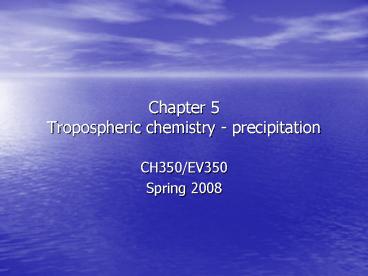Chapter 5 Tropospheric chemistry precipitation - PowerPoint PPT Presentation
1 / 21
Title:
Chapter 5 Tropospheric chemistry precipitation
Description:
Analyte deposition with water based particles (rain, snow, sleet, hail, fog) ... emitted by combustion sources burning high sulfur fuel. SO2 emitted by ... – PowerPoint PPT presentation
Number of Views:42
Avg rating:3.0/5.0
Title: Chapter 5 Tropospheric chemistry precipitation
1
Chapter 5Tropospheric chemistry - precipitation
- CH350/EV350
- Spring 2008
2
Precipitation
- Wet deposition
- Analyte deposition with water based particles
(rain, snow, sleet, hail, fog) - Rainout analytes incorporated into cloud
droplets - Washout analytes incorporated into
precipitation as it falls through the air - Dry deposition (subject of chapter 6)
- Analyte deposition on dry particles or gaseous
adsorption to earth surface
3
Composition of rain
- Rain water is at equilibrium with atmospheric
gases - Henrys Law (H) relates the atmospheric pressure
(P) with the aqueous concentration (C) at
equilibrium - CO2 chemistry more complicated
- CO2 378 ppmv
- CO2 in air leads to H ions in solution
- Unpolluted rain pH 5.7 due to dissolved CO2
4
Composition of rain affected by chemical and
biological process in region
- Na and Cl- usually derived from ocean
- Ca2 and Mg2 from dust minerals
- NH4 from animal and plant decomposition and
fertilizers
5
Sulfur and Nitrogen species leads to acidity in
precipitation
- Natural and anthropogenic sources
6
Nitric acid chemistry
- NOx chemistry leads to HNO3
- NO is converted to NO2 by various methods
- NO2 can generate HNO3 directly or through NO3
pathways - HNO3 can be removed by wet or dry deposition or
by reaction with NH4
.NO ? .NO2 numerous pathways .NO2 .OH M ?
HNO3 M .NO2 O3 ? .NO3 O2 .NO3 RH ? .R
HNO3 .NO3 .NO2 ? N2O5 N2O5 H2O ? 2HNO3 NH3
HNO3 ? NH4NO3
7
Sulfur chemistry SO2 production
- Many natural sources of sulfur H2S, CS2, (CH3)2S,
COS, CH3SH in -2 oxidation state - Oxidation of sulfur to SO2 (4 oxidation state)
by various pathways - COS relatively stable kinetically
- SO2 also emitted by combustion sources burning
high sulfur fuel - SO2 emitted by volcanoes
- 1991 Mount Pinatubo released 20 Mtons SO2, 10 of
global anthropogenic releases
H2S .OH ? H2O .SH CS2 .OH ? COS .SH COS
.OH ? CO2 .SH .SH O2 ? SO .OH .SH O3 ?
SHO. O2 SHO. O2 ? SO .OOH SO O2, O3, NO2
? SO2 other products
8
Sulfur chemistry SO2 oxidation
- Homogeneous and heterogeneous (in cloud water
droplets) oxidation of SO2 to H2SO4 (sulfuric
acid, strong acid)
SO2 .OH M ? HOSO2 M HOSO2 O2 M ? HOO.
SO3 M SO3 H2O ? H2SO4 SO2(g) ?
SO2(aq) SO2(aq) 2H2O(l) ? HSO3-(aq)
H3O(aq) HSO3-(aq) H2O2(aq) ? HOOSO2-(aq)
H2O HOOSO2-(aq) rearranges to HSO4-
9
Global sources of Nitrogen and Sulfur compounds
- Reduced sulfur leads to acid rain, sulfur already
in 6 oxidation state (SO42-) does not cause acid
rain
10
(No Transcript)
11
Why is the pH profile this way?
12
Problems with acid rain
- Lowers pH of soils (can cause nutrient leaching)
- Lowers pH of surface water
- Stress on plants, animals, and other organisms
- Dissolving of limestone structures
13
- Disease and Insects usually kill a forest
stressed by acid rain
14
- Limestone Acid Rain ? dissolved minerals
- CaCO3(s) H(aq) ? Ca2(aq) HCO3-(aq)
15
What is being done?
- Cap and Trade policy
- In 2000 emissions were capped at 9.5 million tons
(17.3 million tons in 1980) - Each power plant is allowed a certain quantity of
emissions. - If they dont emit their quantity they can sell
the rights to another company to emit the
remainder of the emissions.
16
Prevent SO2 emissions
17
Have we been successful?
- Sulfate emissions
- pH changes?
18
1994
19
1999
20
2004
21
(No Transcript)































